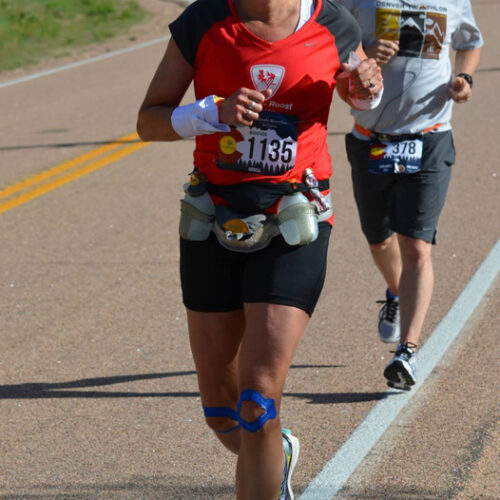We’ve all been there – that moment in the race or that last interval where you begin to tighten up, your breathing gets heavy, your legs begin to burn, and you think to yourself, “I can’t do this, it hurts too bad!” In that moment you have a choice: you can choose to succumb to the pain and slow down or you can hang in there for a little while longer and push through it. Once we make that choice to give into the pain it is extremely difficult, if not impossible, to recover and get back on track. Our bodies can always go further than our mind tells us we can, but our brains are really good at tricking us into believing that if we slow down we’ll feel better. However, we usually don’t feel better even when we slow down! At that point it is going to hurt no matter what so you might as well push through it and reap the benefits of a great performance or the satisfaction of knowing you gave it your all! In those moments, I always think of the infamous words of my college coach, “It’s going to hurt whether you go fast or slow, but the faster you run the sooner you’ll be done.”
Pushing through the pain is easier said than done, but here are a few tips that research shows will increase your chances of hanging on a little longer during those difficult moments.
1. Understand and learn to recognize the difference between pain and discomfort. Most of the time when we say we are in pain, what we really mean is that we are uncomfortable. Although true pain should not be pushed through, we can push through discomfort!
2. Understand that pain and discomfort have a major psychological component. How you think about the pain/discomfort and the emotions you attach to it will affect the pain or discomfort you feel. Therefore, how you interpret your discomfort will either propel you or hinder you.
3. Use positive self-talk! When you start to feel discomfort instead of telling yourself “it hurts too bad,” or “I can’t do this,” try changing your thoughts to something more productive such as, “pain is normal and everyone is feeling it,” “pain means I am pushing myself to the limit so let’s see how far I can go,” “a little bit of discomfort equals big rewards,” or “I’ve come too far to give in now.” Find a statement that works for you!
4. Attach a positive emotion to your discomfort. Just as much as negative emotions increase the perception of pain and discomfort; positive emotions can have the opposite effect. Barb Fredrickson has done some amazing research on the role of positive emotions. She has found that one of the major benefits that positive emotions have is what’s called “The Undoing Effect,” which means they help to bring our body back down to baseline when we are stressed. Connecting a positive emotion such as excitement, fulfillment or pride to the pain you are feeling will help to change the way you interpret your discomfort.
5. Relax! When you begin to struggle the body tires to protect itself by tightening up. Although this is a defense mechanism it actually makes the discomfort and your performance much worse. So when you start feeling uncomfortable and you notice yourself starting to tense up focus on your breathing and maintaining your form. Try taking some deep breaths, rolling your shoulders, standing up straighter, shaking out your arms, relaxing your face, and/or pumping your arms. This will also help to take your focus away from the discomfort and onto maintaining good form.
All of these techniques take practice. Each time you do a workout try to hang on a little longer or push though the discomfort for a few seconds more. If you train your body to be comfortable while uncomfortable there will be huge payoffs in your performance. Call us today for more tips and ideas for out smarting the pain!
Written By Ashley Corn: Ashley Corn is the Owner and Lead Consultant of G.U.T.S. Coaching Services, the only coaching company in the Front Range that is devoted solely to the training the mental side of performance. For more information or to sign up for G.U.T.S. FREE monthly newsletter, visit their website at www.gutscoachingservices.com.
















Recent Comments